For the third Friday afternoon/evening activation event for the VK5 National and Conservation Parks Award, held on Friday 15th January 2016, I headed out to the Ettrick Conservation Park, VKFF-1029.
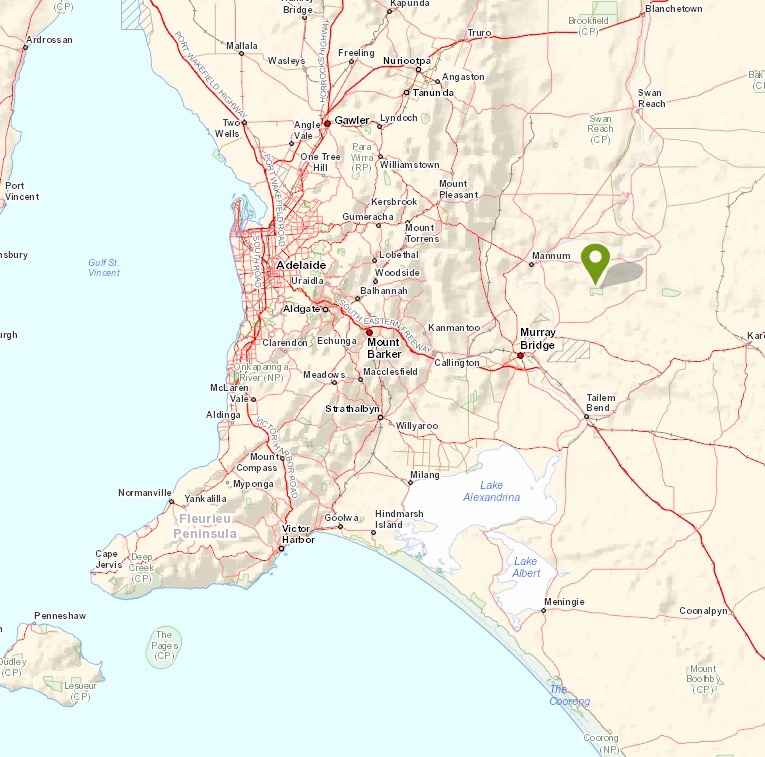
Above:- Map showing the location of the Ettrick CP in the Murray Mallee. Image courtesy of Location SA Map Viewer.
Ettrick CP is situated about 112 km east of Adelaide and about 32 km north east of Murray Bridge. It is a newly formed park, and was proclaimed on 31st October 2013. The park is about 484 hectares in size and predominantly comprises open mallee and several species of eucalypt. It also contains some of the few remaining examples of tussock grassland in the Murray Darling Basin. A number of vulnerable South Australian birds call the park home, including the malleefowl, Shy Heathwren, Hooded robin, White winged cough, Jacky Winter, Restless flycatcher, Painted Button quail, and the Regent parrot.
The park is NOT signposted, so check your maps prior to leaving home. There is a lot of scrub in this area which can be confused for the park.
I headed east along the South Eastern Freeway and took the turn off onto the Old Princes Highway and then headed north east along the Karoonda Highway, passing the Bowhill Road, and continuing north on Burdett Road. I then turned right onto Glenburr Road. Keep your eyes peeled, as Glenburr Road only has a very small sign indicating its presence.
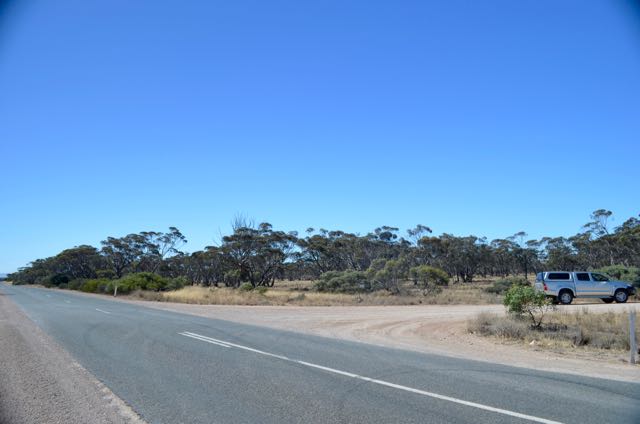
Above:- The Burdett Road and Glenburr Road intersection.
I travelled about 10 km east on Glenburr Road, which is a dirt road, but is in good condition. I then reached the junction of Glenburr Road and Boundary Road. This is the north western corner of the park.
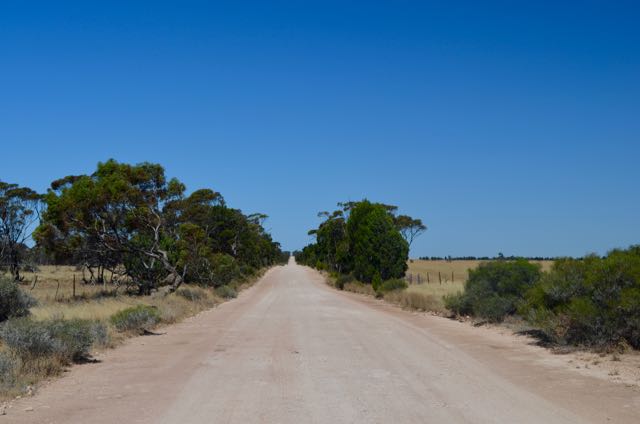
Above:- Looking east along Glenburr Road towards the park
I found that there weren’t too many operating opportunities in the park. There are 2 entry points on the northern side of the park off Glenburr Road. One has an unlocked gate, whilst the other has no gate at all. However both indicated that entry to those parts of the park were closed due to weed eradication issues. I remember Geoff VK5HEL activating this park a long time ago and telling me about the presence of the signs. I wonder if DEWNR have just forgotten to take them down? Anyway, I didn’t want to test my luck, so I headed to the north western corner of the park where there were no signs and found a little clearing in the mallee scrub.
This is another issue. The mallee in the park is very thick, so it is quite difficult to find a clearing, enabling you to stretch out a dipole.
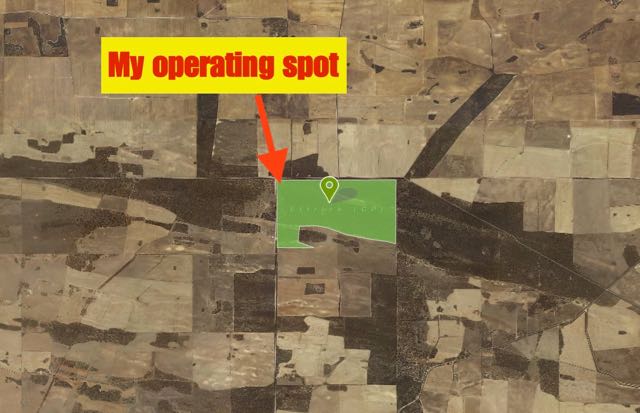
Above:- Map showing my operating spot in the Ettrick Conservation Park. Image courtesy of Location SA Map Viewer.
Much of the land surrounding the park has been cleared for agricultural purposes. It is a stark contrast to see the barren farming land as opposed to the thick mallee scrub. Much of this scrub would have been cleared during the 1800’s. At first the trees were cut down, but settlers soon found that the roots produced regrowth. So the regrowth and the shallow roots were burnt. But this left deep roots which made it impossible for farmers to plough the soil.
Above:- Thick mallee scrub (left) and cleared farming land (right).
This situation had become so frustrating that by 1878 the South Australian Government had offered a £200 reward to anyone who could develop an effective solution to the problem. This resulted in the invention of the stump jump plough which was invented by Richard Bowyer Smith. The plough comprised a number of hinged shares. When the blade encountered an underground obstacle such as a mallee stump, it would rise out of the ground. Weights which were attached to the plough, forced the blade back in the ground when the mallee root was passed.
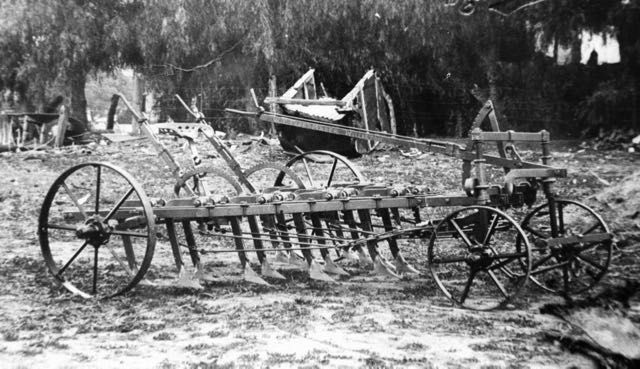
Above:- the stump jump plough. Image courtesy of wikipedia.
I found a little clearing in the scrub and set up my fold up table and deck chair. I ran my normal park operating equipment for this activation, consisting of:-
- Yaesu FT857d, 40 watts
- 40m/20m linked dipole
- 15m dipole
- 7 metre telescopic squid pole
It was a warm (26 degree C) day, but it was very windy. I lost the squid pole when setting up, as I hadn’t driven the squid pole holder firm enough into the sandy ground. I was flying the VK5 Parks Award flag for the first time and that was certainly moving around in the very strong breeze.
I was set up and ready to go by around 0700 UTC (5.30 p.m. South Australian local time). I headed for my nominated operating frequency of 7.144 and started calling CQ. It took a few calls, but I finally had my first contact in the log. It was Russ VK2BJP with a good 5/9 signal. This was followed by Steve VK3YW who was 5/9 plus, Alan VK3DXE and then Scotty VK7NWT. Contact number 8 was with Roger VK5NWE who was operating portable from Mulyungarie Station near the South Australian/New South Wales border, not far from Broken Hill. Roger was up there doing some electrical work.
My ninth contact was my first park to park for the activation, and it was with John VK5BJE who was operating portable in the Mark Oliphant Conservation Park in the Adelaide Hills. John was quite low down, but due to the non existant man made noise in the park, I was able to hear him very well. John has a great WordPress site, with details about his park & SOTA activations. It can be found at…..
I continued to work the steady flow of callers, battling with a little bit of USA DX on the frequency as well. Conditions on 40m were excellent, with some very strong signals from the east coast. Clearly the close in propagation was not working, as I had very few calls from VK5. And those that did call in were very low down.
Contact number 36 was another park to park. This time it was Adrian VK5AW who was activating the Lyrup Flats section of the Murray River National Park. This was Adrian’s first time out for a Friday VK5 Parks event, so I was very pleased to get Adrian in the log.
Contact number 44, qualifying the park for me, was George VK3MVP, who has recently upgraded his call from VK3FJUD. Congratulations George and what a great signal you had with your StepIR.
A few QRP stations called in. They included John VK7HRS operating with 5 watts (5/5 sent), and Rod VK4FLYT also running 5 watts (5/7 sent). I also worked a couple of mobiles including Peter VK3TKK/m (5/8 sent) and Alan VK3FPBI/m (5/8 sent).
After working a total of 52 stations on 40m I headed over to 20m and started calling CQ on 14.310. First taker there was Mr. Reliable, Rick VK4RF/VK4HA. Rick kindly spotted me which resulted in a few European callers. However, band conditions were very poor, and my only successful DX contact was with Xaver DK4RM. Sorry to Luciano I5FLN and Sergey RA3PCI, who were 2 of the European stations that I heard calling in. Unfortunately we were not able to successfully exchange signal reports, making the contact void. I was pleased though, to get John VK6NU in the log from Western Australia. Propagation on 20m was very disappointing again, and the Over the Horizon Radar (OTHR) did not help either.
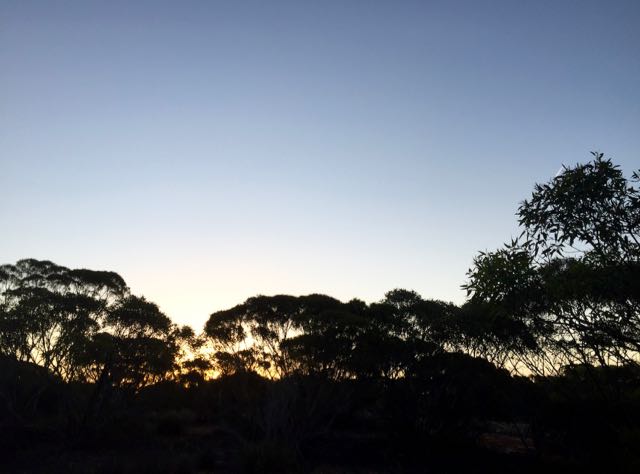
Above:- The sun setting at Ettrick.
I then tried my luck on 15m, calling CQ a few dozen times on 21.244, with no takers. Unfortunately I had no mobile phone coverage in the park, so I was unable to spot myself on parksnpeaks. A quick listen across 15m resulted in me hearing a weak VU2 from India calling CQ, and a moderately strong RK9 working a very weak French station.
So I headed back to 40m and found Mark WC1X calling CQ on 7.133 from northern California. Mark had a good strong 5/9 signal and nobody was coming back to his CQ call so I tried my luck, and got through in the second call. I then booked in to the 7130 DX Net, where I worked a total of 10 stations in New Zealand, French Polynesia, VK2, VK5, and VK7. This included a contact with Peter using a Magnetic loop antenna. Peter was 5/9 plus.
I then left the net and found Rob VK4FFAB calling CQ from the Great Sandy National Park, VKFF-0216, with a very strong 5/9 signal. This was my third park to park contact for the activation.
I then moved down to 7.139 and called CQ and this was answered by Steve VK4QQ who had a strong 5/9 signal, followed by Mike VK6MB who was also 5/9 from Western Australia. I worked a further 19 stations on 7.139 including Owen ZL2OPB in New Zealand, and my two mates Ted VK6NTE and Greg VK8GM. Unfortunately a combination of deliberate QRM in the form of tuning and a very strong DU7 station on 7.140, brought the activation to a sudden halt.
I had a total of 89 contacts in the log, and another unique park under my belt for both the VK5 National & Conservation Parks Award, and the World Wide Flora Fauna (WWFF) program. Thanks to everyone who called in, and I hope I was able to give some park hunters, a new park.
The following stations were worked on 40m SSB:-
- VK2BJP
- VK3YW
- VK3DXE
- VK7NWT
- VK2VW
- VK5KLV
- VK3PMG
- VK5NWE/p
- VK5BJE/p (Mark Oliphant Conservation Park).
- VK3HRA
- VK2IO
- VK3FLCS
- VK1DI
- VK3FGMO
- VK3TKK/m
- VK2SK
- VK4RF
- VK4HA
- VK7DIK
- VK3OF
- VK2FROD
- VK3AWG
- VK1HW
- VK7CW
- VK2YK
- VK3PF
- VK3SIM
- VK3MCK
- VK3FIRM
- VK3KCD
- VK3RU
- VK3GTS
- VK2NP
- VK5GJ
- VK5AW/p (Murray River National Park)
- VK7HRS
- VK1NS
- VK5FAKV
- VK4MWG
- VK4FAAS
- VK4ND
- VK2MOR
- VK3FINE
- VK3MVP
- VK3FADM
- VK2HHA
- VK7KJL
- VK2RI
- VK2FBBB
- VK3FPBI/m
- VK2GG
- VK4FLYT
- WC1X
- VK7ROY
- ZL2ASH
- VK7DON
- VK5FAKV
- VK2NED
- VK2PV
- FO5JV
- VK6WE
- VK2JNG/p
- VK7FGGT
- VK4FFAB/p (Great Sandy National Park)
- VK4QQ
- VK6MB
- VK4GSF
- ZL2OPB
- VK5FANA
- VK3MPV
- VK2NN
- VK6NTE
- VK8GM
- VK3KRH
- VK2YOJ
- VK4RF
- VK4HA
- VK4FAIE
- VK3RU
- VK2XJM
- VK3VIN
- VK2KNC
- VK2QA
- VK3FPSR
- VK4FATS
The following stations were worked on 20m SSB:-
- VK4RF
- VK4HA
- DK4RM
- VK6NU
References.
Wikipedia, 2015, <https://en.wikipedia.org/wiki/Stump-jump_plough>, viewed 16th January 2016



One of the first parks I activated and I drove around it looking for access without the signs you mentioned. I worked from approximately the same spot but left my vehicle outside and jumped the fence to get everything within the perimeter.
Always great to have a repository of activation spots within parks for future use as I recall spending over an hour looking for a suitable spot.
Great to see the flag up!!
Howdy Chris,
Yes this is not an easy park to activate from. I drove up and down Glenburr Road trying to find a suitable spot, both of the gates had the signs saying to keep out. So I went back to that SE corner.
The flag flew very proudly.
Best 73 mate,
Paul,
VK5PAS.
Hi Paul, another splendid post on your activation. I was delighted to have a park to park contact with you: signals were not strong as you stated but we made it. I was also able to work Adrian, VK5AW/P at Murray River National Park and Peter, VK5PET, at Mount George CP. I was happy with the results and will write up my post soon.
cheers
John Dawes
VK5BJE
G’day John,
Although you were low down I was able to hear you perfectly, as there was no man made noise from Ettrick. I wish it was like that at home. I managed to work Adrian as well, which I was very pleased with, because it was Adrian’s first Friday park activation. Unfortunately I missed Peter. I think Col & Tom will probably be out again next Friday, as they had the SERG meeting last Friday. As did the AREG boys, so I expect they’ll be out as well.
Best 73,
Paul,
VK5PAS.
Hi Paul, Im sorry I missed your Ettrick CP Activation.I was also surprised to hear the signs are still in place. Ettrick CP has access to the MB repeater VK5RMB 146.875. There are locals who monitor it, I being one and more than happy to spot.
Friday unfortunately I had an appointment in Adelaide on Friday and missed a good opportunity.
I notice of late there is growing activity on 10mtrs. 28.490mhz seems to be the listen/call channel after which they move up or down to keep it clear, this could be of some use to future park activators. (Its just another plug in the linked dipole.)
Since November I have been using 28.515mhz on Sunday mornings to relay the WI broadcast with reasonable success mostly from the eastern states. VK2, 3, 4. and one pre broadcast contact from a KC2something mobile Seattle. Regards 73s Geoff VK5HEL.
Howdy Geoff,
I’m going to send an email to DEWNR to see if the signs are still current. They probably forgot to take them down.
OK on the repeater, I will keep that in mind. Have 2m and 70cm in the car, and should use it more often.
As for 10m, there is a 10m/6m challenge award going at the moment for the Summits on the Air program. There have been some very nice signals from some of the VK1 and VK2 SOTA activators on 10m of late as you say.
All the best mate & HNY 2016.
Paul,
VK5PAS.
Hi Paul, Sorry that I was not out and about but the S.E.R.G. had an activity night at the Mt. Burr transmitter site and we couldn’t make it.
Next time. 73
Howdy Col,
It was another good night out in the bush. But unfortunately the close in propagation was an issue again. 20m long path to Europe was not working either. Hope you enjoyed the night at Mount Burr.
Cheers,
Paul,
VK5PAS.
Pingback: Ettrick Conservation Park 5CP-267 and VKFF-1029 and FYBO | vk5pas